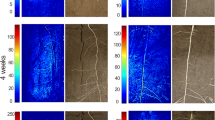Abstract
Bacterial growth rates on the rhizoplane of rape seedlings grown in sand were determined using 3H-thymidine incorporation into DNA. Axenic roots incorporated thymidine into DNA, which had to be subtracted from values for roots with associated bacteria. Thymidine incorporation into rhizoplane bacterial DNA ranged between 0.6 and 1.4 pmol thymidine h−1 root−1 for 6 to 26-day-old plants. Using a conversion factor, the turnover time of bacteria was calculated to decrease from 9.2 h for 6-day-old plants to 160h for 26-day-old plants. A similar value was found for rhizosphere bacteria of plants grown for 26 days in natural soil.
Similar content being viewed by others
References
Bååth E 1990 Thymidine incorporation into soil bacteria. Soil Biol. Biochem. (In press.)
Barber D A and Lynch J M 1977 Microbial growth in the rhizosphere. Soil Biol. Biochem. 9, 305–308.
Bell R T 1986 Further verification of the isotope dilution approach for estimating the degree of participation of [3H]thymidine in DNA synthesis in studies of aquatic bacterial production. Appl. Environ. Microbiol. 52, 1212–1214.
Bennett R A and Lynch J M 1981 Bacterial growth and development in the rhizosphere of gnotobiotic cereal plants. J. Gen. Microbiol. 125, 95–102.
Bloem J, Starink M, Bär-Gilissen M-J B and Cappenberg T E 1988 Protozoan grazing, bacterial activity, and mineralization in two-stage continuous cultures. Appl. Environ, Microbiol. 54, 3113–3121.
Bowen G D and Rovira A D 1976 Microbial colonization of plant roots. Annu. Rev. Phytopathol. 14, 121–144.
Chin-Leo G and Kirchman D L 1988 Estimating bacterial production in marine waters from the simultaneous incorporation of thymidine and leucine. Appl. Environ. Microbiol. 54, 1934–1939.
Christensen H, Funck-Jensen D and Kjöller A 1989 Growth rate of rhizosphere bacteria measured directly by the tritiated thymidine incorporation technique. Soil Biol. Biochem. 21, 113–117.
Chrost R J, Overbeck J and Wcislo R 1988 Evaluation of the [3H]thymidine method for estimating bacterial growth rates and production in lake water: Re-examination and methodological comments. Acta Microbiol. Pol. 37, 95–112.
Coveney M F and Wetzel R G 1988 Experimental evaluation of conversion factors for the [3H]thymidine incorporation assay of bacterial secondary productivity. Appl. Environm. Microbiol. 54, 2018–2026.
Fallon R D and Newell S Y 1986 Thymidine incorporation by the microbial community of standing dead Spartina alterniflora. Appl. Environ. Microbiol. 52, 1206–1208.
Findlay S E G, Meyer J L and Edwards R T 1984 Measuring bacterial production via rate of incorporation of [3H]thymidine into DNA. J. Microbiol. Meth. 2, 57–72.
Fuhrman J A and Azam F 1980 Bacterioplankton secondary production estimates for coastal waters of British Columbia, Antarctica, and California. Appl. Environ. Microbiol. 39, 1085–1095.
Giovanetti M and Mosse B 1980 An evaluation of techniques for measuring vesicular-arbuscular mycorrhizal infection in roots. New Phytol. 84, 489–500.
Jeffrey W H and Paul J H 1988a Effect of 5-fluoro-2′-deoxyuridine of [3H]thymidine incorporation by bacterio-plankton in the waters of southwest Florida. Appl. Environ. Microbiol. 54, 331–336.
Jeffrey W H and Paul J H 1988b Underestimation of DNA synthesis by [3Hthymidine incorporation in marine bacteria. Appl. Environ. Microbiol. 54, 3165–3168.
Kacperska-Palacz A, Dlugokecka E, Reitenwald J and Wcislinska B 1977 Physiological mechanism of frost tolerance: Possible role of protein in plant adaptation to cold. Biol. Plant. 19, 10–17.
Kirchman D L and Hoch M P 1988 Bacterial production in the Delaware Bay estuary estimated from thymidine and leucine incorporation rates. Mar. Ecol. Prog. Ser. 45, 169–178.
Mineyuki Y, Wick S M and Gunning B E S 1988 Preprophase bands of microtubules and the cell cycle: Kinetics and experimental uncoupling of their formation from the nuclear cycle in onion root-tip cells. Planta 174, 518–526.
Moriarty D J W 1986 Measurement of bacterial growth rates in aquatic systems from rates of nucleic acid synthesis. Adv. Microb. Ecol. 9, 245–292.
Moriarty D J W and Pollard P C 1982 Diel variation of bacterial productivity in seagrass (Zostera capricorni) beds measured by rate of thymidine incorporation into DNA. Mar. Biol. 72, 165–173.
Nierlich D P 1978 Regulation of bacterial growth, RNA and protein synthesis. Annu. Rev. Microbiol. 32, 393–432.
Olsson S Bååth E and Söderström B 1987 Growth of Verticillium dahliae Kleb. hyphae and of bacteria along the roots of rape (Brassica napus L.) seedlings. Can. J. Microbiol. 33, 916–919.
Pollard P C and Moriarty D J W 1984 Validity of the tritiated method for estimating bacterial growth rates: Measurement of isotope dilution during DNA synthesis. Appl. Environ. Microbiol. 48, 1076–1083.
Riemann B and Söndergaard M 1984 Measurements of diel rates of bacterial secondary production in aquatic environments. Appl. Environ. Microbiol. 47, 632–638.
Robarts R D, Wicks R J and Sephton L M 1986 Spatial and temporal variations in bacterial macromolecule labeling with methyl-3H-thymidine in a hypertrophic lake. Appl. Environ. Microbiol. 52, 1368–1373.
Servais P, Martinez J, Billen G and Vives-Rego J 1987 Determining [3H]thymidine incorporation into bacterioplankton DNA: Improvement of the method by DNase treatment. Appl. Environ. Microbiol. 53, 1977–1979
Weber G, de Groot E and Schweige H-G 1986 Synchronization of protoplasts from Glycine max (L.) Merr. and Brassica napus (L.). Planta 168, 273–280.
Yasuda T, Kuroiwa T and Nagata T 1988 Preferential synthesis of plastid DNA and increased replication of plastids in cultured tobacco cells following medium renewal. Planta 174, 235–241.
Author information
Authors and Affiliations
Rights and permissions
About this article
Cite this article
Bååth, E., Johansson, T. Measurement of bacterial growth rates on the rhizoplane using 3H-thymidine incorporation into DNA. Plant Soil 126, 133–139 (1990). https://doi.org/10.1007/BF00041379
Received:
Issue Date:
DOI: https://doi.org/10.1007/BF00041379




